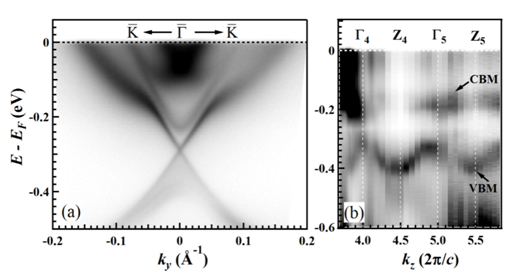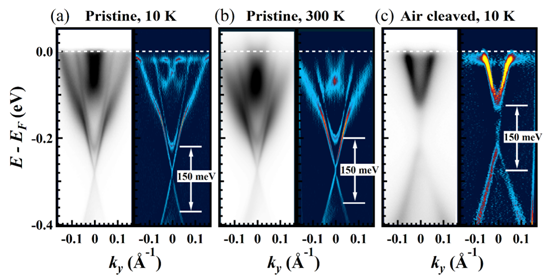Recently, groups led by Associate Professors Chang Liu and Qihang Liu from the Department of Physics at Southern University of Science and Technology (SUSTech), and Associate Researcher Chaoyu Chen from the Shenzhen Institute for Quantum Science and Engineering (SIQSE) have made important progress in magnetic topological materials. The experimental and theoretical results have been published in the physics journal Physical Review X. This work is also featured in the review magazine Physics.


Figure: Existence and stability of a Dirac cone topological surface state in MnBi2Te4 without an energy gap. Top: X-shaped topological surface state (left) and the kz dispersion (right) of adjacent energy bands. Second line: Stability of the topological surface state.
Topological insulators are a hot material in the research of condensed matter physics in recent years. It has insulating internal and conductive surfaces, with potential applications in topological electronics, nonlinear optics, and topological quantum computing. With the introduction of long-range magnetic orders in topological insulators, theoretically, specific surfaces of these magnetic topological insulators (MTIs) will no longer conduct electrons, but will instead exhibit insulating behavior.
Antiferromagnetic topological insulators with certain specific spin arrangements are particularly important in this field because they may exhibit two peculiar phenomena at the same time. The exhibition of both the “quantum anomalous Hall effect” and the “axion insulator state” is unusual with the insulating behavior of specific surfaces being a prerequisite for achieving the latter. However, the research team found through systematic experiments that, in an MTI, the surface that should be insulating is actually conductive. This unique behavior shows that the handling of magnetic topological materials in nature is far more complicated and interesting than previously thought.
To reveal this surprising behavior, the team used a powerful surface physics experimental tool called angle resolved photoelectron spectroscopy (ARPES) to study the antiferromagnetic topological insulator MnBi2Te4. Theoretical predictions and previous experiments show that this recently synthesized material is the first ideal antiferromagnetic topological insulator, and its natural cleavage surface should be insulating. The team’s irrefutable high-quality data clearly shows that its surface energy band forms a complete X shape, proving that the surface conducts electricity in an unusual, topologically protected manner. The data directly overturned previous experimental conclusions, and leads the study of magnetic topological systems into a new stage. The research group believes that this strange behavior may be caused by surface magnetic or structural reconstruction. First-principles calculations in the paper reveal several possible surface magnetic structures that support this unusual state of conduction.
The results of this study pave the way for future research works on antiferromagnetic topological materials. For example, future work may find a way to overcome this surface reconstruction to obtain the axion insulator state, or make use of this reconstruction to build a device with novel quantum transport behavior.
This result was published online in Physics Review X on November 21, 2019, and Physics published a synopsis article entitled “Skimming the Surface of Magnetic Topological Insulators” on the same day. Yu-Jie Hao, Ph.D. student in Chang Liu’s group, Pengfei Liu, an undergraduate in Qihang Liu’s group, and Yue Feng, an undergraduate in Chang Liu’s group, are the co-first authors. Chaoyu Chen, Qihang Liu and Chang Liu are the corresponding authors.
This article was completed in cooperation with the Department of Physics and the Shenzhen Institute for Quantum Science and Engineering (SIQSE), the Hiroshima Synchrotron Radiation Center at Hiroshima University, the Department of Physics of the University of California Los Angeles (UCLA), and the Guangdong Key Laboratory of Computational Science and New Materials Design. The Department of Physics and the Shenzhen Institute for Quantum Science and Engineering (SIQSE) is the leading affiliation of the article.
This work was supported by the National Natural Science Foundation of China (NSFC), NSFC Guangdong, the Guangdong Innovative and Entrepreneurial Research Team Program, the Shenzhen Peacock Plan Team, the Shenzhen Key Laboratory, and the Technology and Innovation Commission of Shenzhen Municipality. The research team would like to thank the Hiroshima Synchrotron Radiation Center for their strong support for the work.
Physical Review X (PRX) is a new top physics journal launched by the American Physical Society in 2011 with an impact factor of 12.211 in 2018. It publishes selected papers from various fields of physics, which may influence current and future research and have long-term and profound impacts in its related fields. This article is the first paper accepted by the journal with SUSTech as the leading affiliation.
Physics is an open-access, online journal of the American Physical Society. The journal mainly reports on papers in the Physics Review series of journals, focusing on research results that will change the research process, stimulate new ways of thinking, or stimulate curiosity. The stories behind these discoveries were written by experts, journalists and Physics staffs to benefit the physics community and beyond.
Paper Link: https://journals.aps.org/prx/abstract/10.1103/PhysRevX.9.041038
Physics Featured article link: https://physics.aps.org/synopsis-for/10.1103/PhysRevX.9.041039
Proofread ByXia Yingying
Photo ByDepartment of Physics, Shenzhen Institute of Quantum Science and Engineering, Qiu Yan